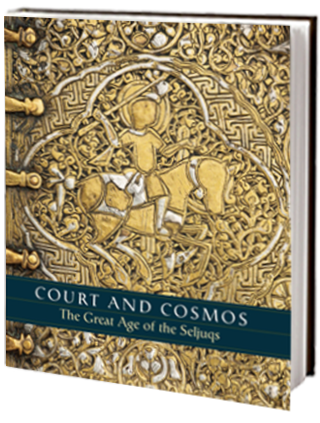
Featuring some 250 objects, this book provides an invaluable record of the great cultural flowering that took place under Seljuq rule.
Buy NowOne of the most productive periods in the history of the region from Iran to Anatolia corresponds to the rule of the Seljuqs and their immediate successors, from 1038 to 1307. The Seljuqs were a Turkic dynasty of Central Asian nomadic origin that in short time conquered a vast territory in West Asia stretching from present-day Turkmenistan, Iran, Iraq, Syria, and Turkey. The lands controlled by the Seljuqs were not a unified empire, but controlled by various branches of the Seljuqs and their successor dynasties (Rum Seljuqs, Artuqids, Zangids, and others). Under Seljuq rule, the exchange and synthesis of diverse traditions—including Turkmen, Perso-Arabo-Islamic, Byzantine, Armenian, Crusader, and other Christian cultures—accompanied economic prosperity, advances in science and technology, and a great flowering of culture within the realm.
This landmark international loan exhibition will feature spectacular works of art created in the 11th through 13th century from Turkmenistan to the Mediterranean. Approximately 270 objects—including ceramics, glass, stucco, works on paper, woodwork, textiles, and metalwork—from American, European, and Middle Eastern public and private collections will be shown. Many of the institutions have never lent works from their collections before. Among the highlights will be a dozen important loans from Turkmenistan, marking the first time that Turkmenistan as an independent country has permitted an extended loan of a group of objects to a museum in the United States.
Under the Great Seljuqs of Iran, the middle class prospered, spurring arts patronage, technological advancements, and a market for luxury goods. In contrast, in Anatolia and the Jazira (northwestern Iraq, northeastern Syria, and southeastern Turkey)—which were controlled by the Seljuq successor dynasties—art was produced under royal patronage, and Islamic iconography was introduced to a predominantly Christian area.
Furthermore, a number of artists had immigrated to the region from Iran in response to the Mongol conquest in 1220. Because patrons, consumers, and artists came from diverse cultural, religious, and artistic backgrounds, distinctive arts were produced and flourished in the western parts of the Seljuq realm.
"...deliciously diverse and unexpected"—Apollo
The exhibition is made possible by the NoRuz at The Met Fund and the Iranian-American Community.
The catalogue is made possible by The Andrew W. Mellon Foundation, the Doris Duke Fund for Publications, and the Marshall and Marilyn R. Wolf Foundation.
Muhammad ibn Abi'l-Qasim ibn Bakran al-Najjar al-Isfahani al-Salihani. Astrolabe (detail), dated A.H. 496/A.D. 1102–3. Iran, Isfahan. Museo Galileo—Istituto e Museo di Storia della Scienza, Florence (1105)